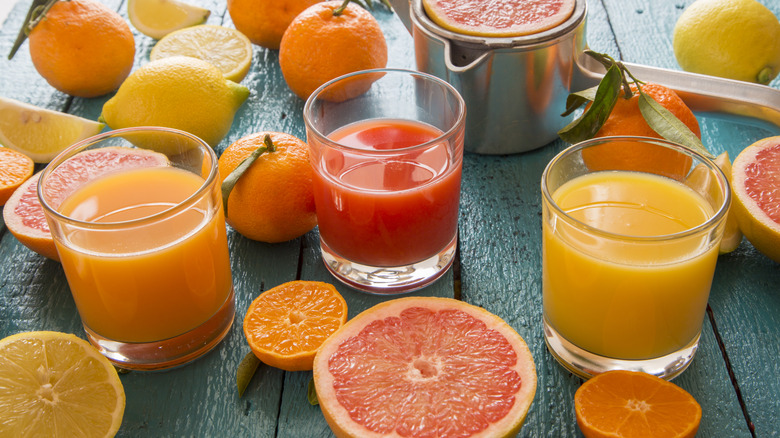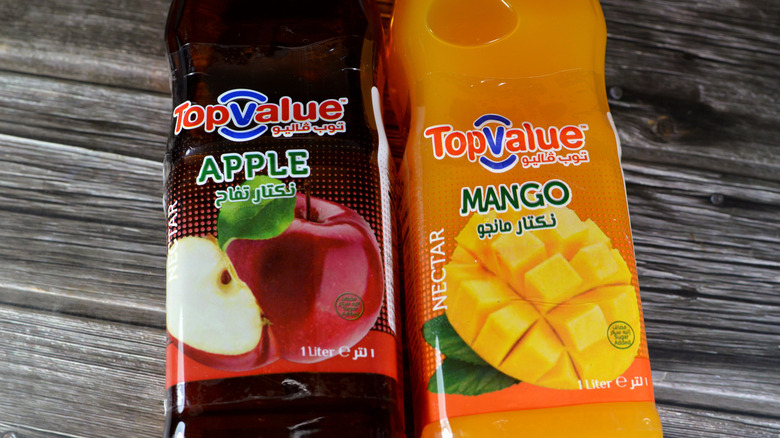No, Nectar And Juice Are Not The Same Thing. Here's The Difference
We may receive a commission on purchases made from links.
Who doesn't enjoy a sweet, fruity beverage on a warm day? Be it freshly made at home or a convenient store-bought option, fruit-based drinks can be effective ways to hydrate yourself while relishing the flavors of your favorite fruits. The most popular fruit beverages you can find stacked up along grocery store aisles are nectar and juice, and chances are you may have unknowingly reached for one only to be thrown off by a different consistency and level of sweetness than what you would have expected. While both nectar and juice feature fruit as the primary ingredient, that's perhaps where their similarities end as they are distinctly different beverages when you break down their composition and production methods.
Pure fruit juice boasts a high fruit content with no added sugars (only the natural sugars present in the fruit). You may also find juice varieties that specify that they are made from juice concentrate, which can be preserved for longer periods due to having its water content filtered out. Fruit nectar, on the other hand, contains fruit juice and added sweeteners like sugar, and also features a thicker consistency than juice. This basic distinction is important for consumers to understand, especially those monitoring their sugar intake or seeking specific nutritional benefits from their fruity beverage.
The juicy journey of making juice
Like any feel-good, countryside story, the juice-making process begins in sun-drenched orchards where ripe fruits hang, ready to be picked and savored fresh or as a refreshing drink. Food regulations define pure juice as a product containing 100% fruit, with no added sugars or artificial ingredients. Commercially produced juices involve extraction and production methods that can significantly impact the juice's final quality and nutritional value. The process begins by blending fruit into a pulp and subjecting it to high-speed spinning in a centrifuge to extract the juice.
To ensure added food safety, once the juice is pressed out of the fruit, it may be subjected to heat treatment, called pasteurization, to eliminate any unwanted, harmful microbes in the mix, which also contributes to an extended shelf life of commercial juice products. Health-conscious consumers may gravitate towards cold-pressed juice varieties. Cold pressing uses hydraulic pressure to extract juice without generating heat. This method preserves more of the fruit's original nutrients and enzymes compared to traditional high-speed juicing methods.
Homemade fruit juices are far simpler to make and you also have full control over the ingredients. Investing in a good-quality juicer like Nama's J2 cold-pressed juicer can make your juice prep and cleanup easier than ever while minimizing food waste from leftover pulp. While many commercial juices and juicers strain out pulp for a smoother texture, retaining pulp offers valuable dietary fiber, which supports digestion and helps regulate blood sugar absorption. At the end of the day, your choice of juice comes down to personal taste and what aligns with your health goals.
The sweet science of how nectar is made
Since the process of making nectar typically involves blending entire fruits into a puree, the primary distinguishing characteristic of this fruit drink is its final composition. Contrary to the 100% fruit content of juice, fruit nectars typically have a minimum of 25% fruit juice, which is combined with water until it's drinkable and select sweeteners. The diluted fruit juice content may serve as a cost-effective approach for beverage producers or as a way to make the fruit drink more palatable for certain fruits that are highly acidic and tart to taste, like currants and black cherries.
Fruit nectars also tend to have a thicker consistency than juice and are sweeter due to the added sugar. When shopping for fruit nectar, you want to ensure good quality, which means little to no added preservatives and a short and sweet ingredient list. Naturally, you can also make your own fruit nectar by blending your favorite fruit, adding water until it achieves your desired consistency, flavoring it with added sweetener if you'd like, then straining and storing it properly. You can add fruit nectar to your favorite cocktails or mocktails. For instance, peach nectar works beautifully for a delectable peach bellini to complement your brunch spread, while pear nectar with warming spices is a key ingredient for a sophisticated sugar and spice pear martini that deserves a spot at an elegant holiday soiree.


